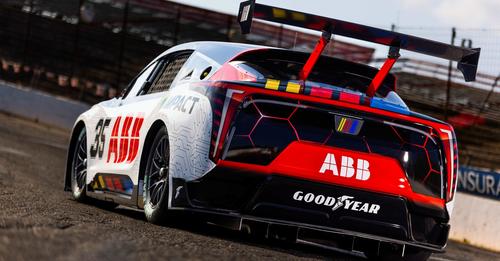
**OFFICIAL NEWS: NASCAR Unveils Electric Racecar Amid Mixed Reactions**
In a bold move toward sustainability and innovation, NASCAR, the famed American motorsport organization, recently unveiled its first-ever electric racecar prototype. The announcement, made amidst much anticipation and skepticism within the racing community, marks a significant departure from NASCAR’s longstanding tradition of high-octane, gasoline-powered machines. While proponents hail this as a pivotal moment in the sport’s evolution toward eco-friendly practices, critics, including veteran racer Kevin Harvick, voice concerns over the future of NASCAR’s identity and competitive landscape.
The unveiling ceremony, held at NASCAR’s state-of-the-art research and development center in Charlotte, North Carolina, showcased the sleek, futuristic design of the electric racecar, christened the E-Racer. Developed in collaboration with leading technology partners and engineers, the E-Racer promises to deliver unparalleled performance while significantly reducing carbon emissions—a crucial factor in NASCAR’s commitment to sustainability.
“This is not just a car; it’s a statement of our commitment to the future,” remarked NASCAR President Steve Phelps during the unveiling event. “We recognize the need to adapt to the changing landscape of motorsports and embrace technology that aligns with our environmental responsibilities.”
The E-Racer’s specifications underscore NASCAR’s ambition to marry speed with sustainability. Powered by a cutting-edge electric drivetrain, the car boasts acceleration rates that rival its traditional counterparts. Its battery technology, developed in partnership with renewable energy experts, ensures extended race durations without compromising power or reliability—a critical concern in motorsport engineering.
However, amidst the buzz of innovation and progress, skepticism looms large among NASCAR’s veteran drivers and enthusiasts. Kevin Harvick, a seasoned NASCAR champion known for his outspoken nature, minced no words in expressing his reservations about the E-Racer initiative.
“I’ve dedicated my career to mastering the nuances of combustion engines, to the roar of gasoline-powered beasts thundering down the track,” Harvick remarked in a candid interview. “The E-Racer is impressive tech-wise, but it’s a departure from what makes NASCAR the exhilarating sport it is.”
Harvick’s sentiments echo a broader sentiment within the NASCAR community, where tradition and heritage intertwine with the relentless pursuit of technological advancement. Critics argue that the shift to electric vehicles risks diluting NASCAR’s unique identity—a sport synonymous with the visceral experience of high-speed, petrol-driven competition.
“I understand the need for sustainability,” continued Harvick, “but NASCAR isn’t just about speed; it’s about the heart-pounding thrill of the race. I’m concerned that electric cars might not deliver the same intensity that fans and drivers crave.”
Despite these reservations, NASCAR remains steadfast in its commitment to fostering innovation and adapting to global trends in automotive technology. The introduction of the E-Racer aligns with broader industry shifts towards electrification, driven by regulatory pressures and consumer demand for greener alternatives.
Industry analysts predict that NASCAR’s embrace of electric vehicles could catalyze a paradigm shift in motorsport, inspiring other racing leagues to explore similar initiatives. The E-Racer’s debut serves as a litmus test for the feasibility of electric propulsion in high-performance racing, potentially reshaping the landscape of motorsport for years to come.
“This is just the beginning,” affirmed Phelps, emphasizing NASCAR’s long-term vision for sustainability and technological leadership. “The E-Racer represents our dedication to innovation and our commitment to creating a more sustainable future for racing.”
Beyond its environmental implications, the E-Racer initiative holds significant economic and strategic implications for NASCAR and its stakeholders. The transition to electric vehicles could open new avenues for sponsorship and partnership opportunities, attracting environmentally conscious brands and investors eager to align with NASCAR’s progressive stance on sustainability.
Moreover, the shift to electric racing could redefine fan engagement strategies, appealing to a new generation of tech-savvy enthusiasts drawn to the allure of cutting-edge automotive technology. NASCAR’s marketing efforts are expected to pivot towards highlighting the E-Racer’s innovative features and its potential to revolutionize the sport, thereby expanding its global audience base.
“We’re entering a new era of racing,” remarked industry analyst Sarah Watson, reflecting on the broader implications of NASCAR’s electric initiative. “The E-Racer represents a convergence of speed, sustainability, and spectacle—a potent combination that could redefine the future of motorsport.”
As NASCAR prepares for the next phase of its electric racing journey, challenges and opportunities abound. The successful integration of the E-Racer into NASCAR’s competitive framework hinges on overcoming technical hurdles, refining race strategies, and addressing the concerns of stakeholders across the racing ecosystem.
“We’re committed to a collaborative approach,” Phelps affirmed, acknowledging the need for ongoing dialogue with drivers, teams, and fans. “The transition won’t be without its challenges, but we’re confident in our ability to lead the charge towards a greener, more thrilling future.”
In conclusion, NASCAR’s unveiling of the E-Racer marks a pivotal moment in the sport’s storied history, sparking debates and discussions that underscore the intersection of tradition and innovation. As the racing community navigates the complexities of embracing electric propulsion, one thing remains certain: the E-Racer represents more than just a technological leap—it embodies NASCAR’s unwavering commitment to pushing boundaries, igniting passions, and shaping the future of motorsport.
Leave a Reply